
Understanding Forex Software Trading: Tools and Strategies
Forex software trading has revolutionized the way traders engage with the currency market. With a plethora of platforms available, each offering unique functionalities, it is crucial to understand how these tools can be utilized effectively. This article will explore the various aspects of forex trading software, including types, features, benefits, and strategies to enhance your trading experience. For detailed insights and services, visit forex software trading Trading Uganda.
What is Forex Trading Software?
Forex trading software refers to the applications used by traders to execute and manage trades in the foreign exchange (forex) market. This software can range from simple mobile applications that allow for basic trading operations to complex platforms equipped with advanced analytics and trading tools.
Types of Forex Trading Software
- Trading Platforms: These are the most common types of forex software, allowing traders to execute buy and sell orders. Some of the popular platforms include MetaTrader 4 (MT4), MetaTrader 5 (MT5), and cTrader.
- Automated Trading Systems (ATS): These systems use algorithms to enter and exit trades on behalf of traders. They can help in executing trades at optimal times, reducing emotional decision-making.
- Charting and Analysis Software: These tools help traders analyze market trends and price movements. They often include technical indicators, drawing tools, and advanced charting capabilities.
- Risk Management Tools: Software that helps traders manage their risk exposure effectively, including features like stop-loss orders and take-profit levels.
Essential Features of Forex Trading Software
When selecting forex software, it is essential to identify important features that can enhance your trading experience:
- User-Friendly Interface: An intuitive interface allows traders to navigate the software easily and manage their trades efficiently.
- Real-Time Data: Access to real-time market data is crucial for making informed trading decisions.
- Customization: The ability to customize trading layouts, indicators, and alerts according to personal preferences can significantly improve usability.
- Backtesting Capabilities: Advanced software provides options for backtesting trading strategies against historical data, helping traders optimize their strategies.
- Customer Support: Reliable customer service can assist with any technical difficulties or questions that may arise.
Benefits of Using Forex Trading Software
Utilizing the right forex trading software can offer numerous advantages to traders:

- Speed and Efficiency: Automated trading software can execute trades much faster than manual trading, taking advantage of small price changes in the market.
- Discipline: Risk management tools built into trading platforms help maintain discipline and enforce trading strategies without succumbing to emotional biases.
- Diversification: Software can facilitate trading across multiple currency pairs, enabling better diversification of a trader’s portfolio.
- Access to Advanced Tools: Many trading platforms offer analytical tools, economic calendars, and market news, providing traders with comprehensive insights into market behavior.
Choosing the Right Forex Software
Choosing the appropriate forex trading software is a subjective process that depends on individual trading styles and preferences. Here are some considerations to guide your selection:
- Experience Level: Beginners may prefer user-friendly platforms with basic functions, while advanced traders might seek sophisticated tools with customization options.
- Broker Compatibility: Ensure that the chosen software is compatible with your forex broker to facilitate smooth trading execution.
- Cost: Some trading platforms are free, while others may charge subscription fees. Determine the budget and choose software that offers the best value for your needs.
- Trial Period: Utilize free trials to assess the software’s features and performance before making a long-term commitment.
Common Strategies Utilizing Forex Software
Forex software can significantly aid in implementing various trading strategies. Here are some widely used strategies:
- Scalping: A short-term strategy that focuses on making small profits from multiple trades throughout the day, often facilitated by automated systems.
- Day Trading: Involves opening and closing trades within the same day. Traders use platforms for real-time analysis and quick decision-making.
- Swing Trading: Focuses on capturing short to medium-term market moves, relying on technical indicators available on trading software.
- Position Trading: This long-term method involves holding trades for days or weeks and is supported by comprehensive analysis tools in trading software.
The Future of Forex Trading Software
As technology continues to advance, the future of forex trading software looks promising. Innovations in artificial intelligence (AI) and machine learning are set to further enhance trading tools, making them more adaptive to market changes. Traders can expect improvements in predictive analytics, which will provide deeper insights into market fluctuations, potentially leading to more strategic trading opportunities.
In conclusion, understanding forex software trading is fundamental for anyone looking to succeed in the forex market. The right tools, equipped with analytical capabilities and user-friendly interfaces, can dramatically improve trading performance. Whether you are a beginner or an experienced trader, investing time in learning about forex trading software can yield significant long-term benefits.
